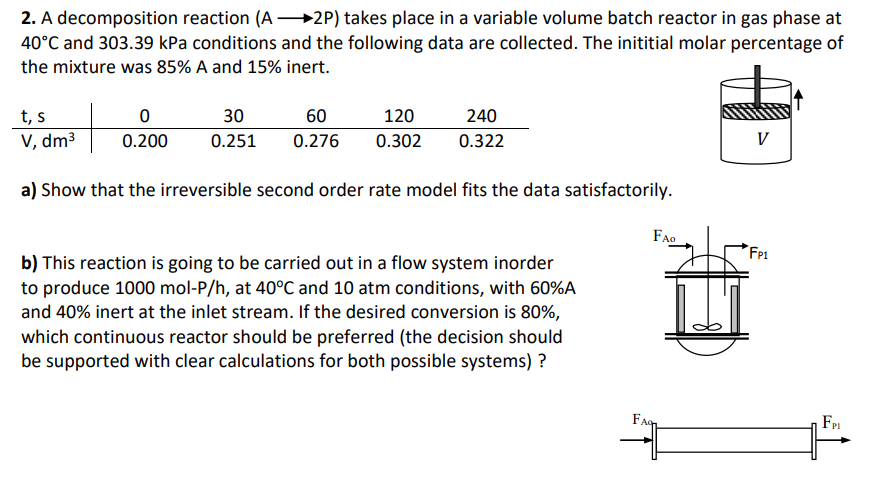2. A decomposition reaction (A +2P) takes place in a variable volume batch reactor in gas phase at 40°C and 303.39 kPa conditions and the following data are collected. The inititial molar percentage of the mixture was 85% A and 15% inert. 30 0.251 120 0.302 t, s 60 240 V, dm3 0.200 0.276 0.322 V a) Show that the irreversible second order rate model fits the data satisfactorily. FAo FP1 b) This reaction is going to be carried out in a flow system inorder to produce 1000 mol-P/h, at 40°C and 10 atm conditions, with 60%A and 40% inert at the inlet stream. If the desired conversion is 80%, which continuous reactor should be preferred (the decision should be supported with clear calculations for both possible systems) ?
2. A decomposition reaction (A +2P) takes place in a variable volume batch reactor in gas phase at 40°C and 303.39 kPa conditions and the following data are collected. The inititial molar percentage of the mixture was 85% A and 15% inert. 30 0.251 120 0.302 t, s 60 240 V, dm3 0.200 0.276 0.322 V a) Show that the irreversible second order rate model fits the data satisfactorily. FAo FP1 b) This reaction is going to be carried out in a flow system inorder to produce 1000 mol-P/h, at 40°C and 10 atm conditions, with 60%A and 40% inert at the inlet stream. If the desired conversion is 80%, which continuous reactor should be preferred (the decision should be supported with clear calculations for both possible systems) ?
Introduction to Chemical Engineering Thermodynamics
8th Edition
ISBN:9781259696527
Author:J.M. Smith Termodinamica en ingenieria quimica, Hendrick C Van Ness, Michael Abbott, Mark Swihart
Publisher:J.M. Smith Termodinamica en ingenieria quimica, Hendrick C Van Ness, Michael Abbott, Mark Swihart
Chapter1: Introduction
Section: Chapter Questions
Problem 1.1P
Related questions
Question

Transcribed Image Text:2. A decomposition reaction (A 2P) takes place in a variable volume batch reactor in gas phase at
40°C and 303.39 kPa conditions and the following data are collected. The inititial molar percentage of
the mixture was 85% A and 15% inert.
t, s
V, dm³
30
60
120
240
0.200
0.251
0.276
0.302
0.322
V
a) Show that the irreversible second order rate model fits the data satisfactorily.
FAO
Fp1
b) This reaction is going to be carried out in a flow system inorder
to produce 1000 mol-P/h, at 40°C and 10 atm conditions, with 60%A
and 40% inert at the inlet stream. If the desired conversion is 80%,
which continuous reactor should be preferred (the decision should
be supported with clear calculations for both possible systems) ?
Faq
FPI
Expert Solution
This question has been solved!
Explore an expertly crafted, step-by-step solution for a thorough understanding of key concepts.
Step by step
Solved in 3 steps with 1 images

Recommended textbooks for you

Introduction to Chemical Engineering Thermodynami…
Chemical Engineering
ISBN:
9781259696527
Author:
J.M. Smith Termodinamica en ingenieria quimica, Hendrick C Van Ness, Michael Abbott, Mark Swihart
Publisher:
McGraw-Hill Education

Elementary Principles of Chemical Processes, Bind…
Chemical Engineering
ISBN:
9781118431221
Author:
Richard M. Felder, Ronald W. Rousseau, Lisa G. Bullard
Publisher:
WILEY

Elements of Chemical Reaction Engineering (5th Ed…
Chemical Engineering
ISBN:
9780133887518
Author:
H. Scott Fogler
Publisher:
Prentice Hall

Introduction to Chemical Engineering Thermodynami…
Chemical Engineering
ISBN:
9781259696527
Author:
J.M. Smith Termodinamica en ingenieria quimica, Hendrick C Van Ness, Michael Abbott, Mark Swihart
Publisher:
McGraw-Hill Education

Elementary Principles of Chemical Processes, Bind…
Chemical Engineering
ISBN:
9781118431221
Author:
Richard M. Felder, Ronald W. Rousseau, Lisa G. Bullard
Publisher:
WILEY

Elements of Chemical Reaction Engineering (5th Ed…
Chemical Engineering
ISBN:
9780133887518
Author:
H. Scott Fogler
Publisher:
Prentice Hall


Industrial Plastics: Theory and Applications
Chemical Engineering
ISBN:
9781285061238
Author:
Lokensgard, Erik
Publisher:
Delmar Cengage Learning

Unit Operations of Chemical Engineering
Chemical Engineering
ISBN:
9780072848236
Author:
Warren McCabe, Julian C. Smith, Peter Harriott
Publisher:
McGraw-Hill Companies, The